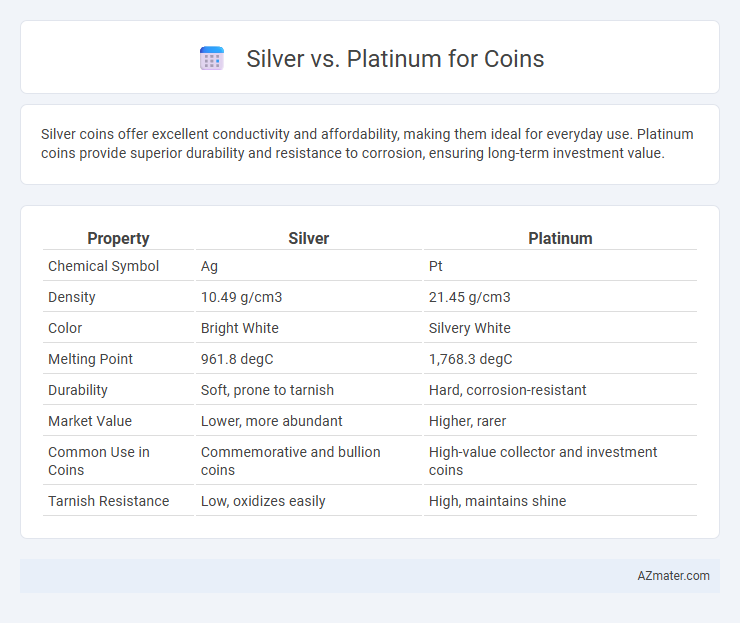Silver coins offer excellent conductivity and affordability, making them ideal for everyday use. Platinum coins provide superior durability and resistance to corrosion, ensuring long-term investment value.
Table of Comparison
| Property | Silver | Platinum |
|---|---|---|
| Chemical Symbol | Ag | Pt |
| Density | 10.49 g/cm3 | 21.45 g/cm3 |
| Color | Bright White | Silvery White |
| Melting Point | 961.8 degC | 1,768.3 degC |
| Durability | Soft, prone to tarnish | Hard, corrosion-resistant |
| Market Value | Lower, more abundant | Higher, rarer |
| Common Use in Coins | Commemorative and bullion coins | High-value collector and investment coins |
| Tarnish Resistance | Low, oxidizes easily | High, maintains shine |
Introduction to Silver and Platinum Coins
Silver coins have been valued for their durability, affordability, and historical significance in numismatics, making them a popular choice for collectors and investors alike. Platinum coins, though rarer and more expensive, offer exceptional density and a distinguished status as a precious metal, often sought after for their unique investment potential. Both metals provide intrinsic value and aesthetic appeal, but silver remains more accessible while platinum appeals to those seeking exclusivity and long-term value.
Historical Significance of Silver vs Platinum Coins
Silver coins have been used as currency and traded commodities for over 2,500 years, playing a crucial role in ancient economies from Greece to Rome, symbolizing wealth and stability. Platinum coins, while rarer, gained prominence only in the 18th and 19th centuries, valued for their durability and resistance to corrosion, but their historical circulation remains limited compared to silver. The enduring legacy of silver coins lies in their widespread use and influence on global monetary systems, whereas platinum coins are more recognized for their modern collectible and industrial significance.
Rarity and Availability: Silver vs Platinum
Platinum is significantly rarer than silver, making platinum coins much more valuable and sought after due to limited global reserves and challenging extraction processes. Silver is more abundant and widely available, resulting in lower prices and easier accessibility for collectors and investors. This rarity disparity directly influences market demand and the long-term investment potential of platinum coins compared to silver coins.
Value and Market Pricing Comparison
Platinum coins typically hold higher market value than silver coins due to platinum's rarity and industrial demand, often trading at prices several times that of silver. Silver coins offer greater affordability and liquidity but are more susceptible to market fluctuations driven by economic factors and investor sentiment. Investors prioritize platinum for its scarcity-driven premium, while silver coins appeal for their accessibility and stable secondary market pricing.
Investment Potential: Silver vs Platinum
Silver offers strong investment potential due to its lower price volatility and extensive industrial demand, making it a practical choice for diversification and long-term value preservation. Platinum, rarer and more expensive, has a higher potential for price spikes driven by its critical role in automotive catalytic converters and emerging green technologies like hydrogen fuel cells. Investors seeking growth might favor platinum's scarcity and industrial applications, while those valuing stability and liquidity often prefer silver coins.
Physical Properties and Durability
Silver coins have a density of 10.49 g/cm3 and exhibit high malleability, making them easier to strike but more prone to scratches and worn surfaces over time. Platinum coins, with a higher density of 21.45 g/cm3, possess superior hardness and resistance to corrosion, resulting in enhanced durability and maintaining sharp details longer. The greater resistance of platinum to tarnishing and environmental damage gives it a lasting physical integrity compared to silver in coinage applications.
Collectibility and Popular Coin Series
Silver coins, prized for their affordability and historical significance, are favored in popular series like the American Silver Eagle and Canadian Silver Maple Leaf, attracting collectors due to high mintage and enduring value. Platinum coins, such as the American Platinum Eagle and Australian Platinum Koala, are rarer and appeal to collectors seeking exclusivity and higher intrinsic value, often featuring limited mintages and unique designs. Collectibility in silver focuses on accessibility and widespread appeal, while platinum emphasizes scarcity and prestige within premium coin collections.
Liquidity and Market Demand
Platinum coins typically exhibit lower liquidity compared to silver coins due to their higher market value and narrower investor base, resulting in less frequent trading activity. Silver coins benefit from robust market demand driven by widespread industrial use and affordability, making them easier to buy and sell quickly. The global investment community generally favors silver for short-term liquidity, while platinum remains a more specialized asset with fluctuating demand tied closely to automotive and jewelry markets.
Storage, Care, and Maintenance
Silver coins require careful storage to prevent tarnishing caused by exposure to air and moisture; airtight containers with anti-tarnish strips are recommended for preservation. Platinum coins are more resistant to corrosion and scratches, making them easier to maintain and store without special treatments. Both metals benefit from handling with cotton gloves and avoiding abrasive cleaning methods to maintain their collector value and aesthetic appeal.
Which is Better: Silver or Platinum Coins?
Silver coins offer affordability and widespread availability, making them a popular choice for collectors and investors seeking liquidity and market stability. Platinum coins, while rarer and typically more valuable per ounce, provide diversification benefits and potential for higher long-term appreciation due to their industrial demand and limited supply. Choosing between silver and platinum coins depends on investment goals, risk tolerance, and market outlook, with silver favored for accessibility and platinum for exclusivity and growth potential.

Infographic: Silver vs Platinum for Coin
 azmater.com
azmater.com